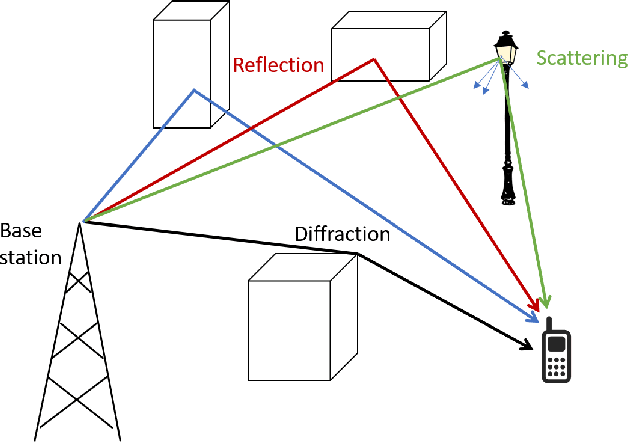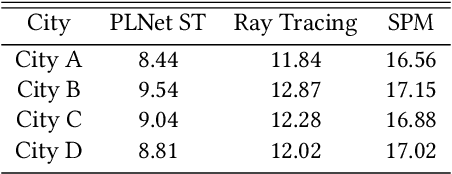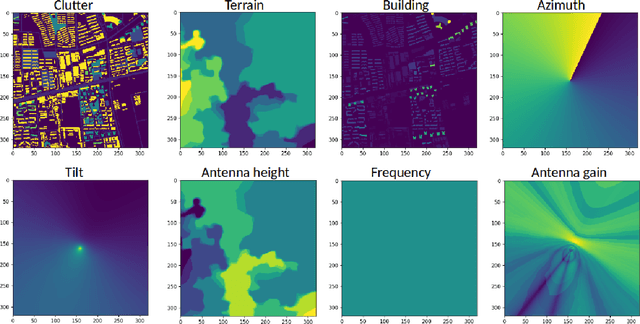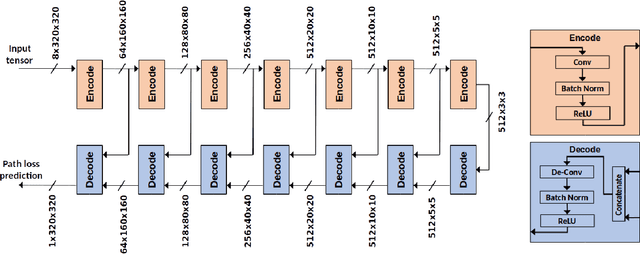Bingwen Zhang
Cellular Network Radio Propagation Modeling with Deep Convolutional Neural Networks
Oct 05, 2021



Abstract:Radio propagation modeling and prediction is fundamental for modern cellular network planning and optimization. Conventional radio propagation models fall into two categories. Empirical models, based on coarse statistics, are simple and computationally efficient, but are inaccurate due to oversimplification. Deterministic models, such as ray tracing based on physical laws of wave propagation, are more accurate and site specific. But they have higher computational complexity and are inflexible to utilize site information other than traditional global information system (GIS) maps. In this article we present a novel method to model radio propagation using deep convolutional neural networks and report significantly improved performance compared to conventional models. We also lay down the framework for data-driven modeling of radio propagation and enable future research to utilize rich and unconventional information of the site, e.g. satellite photos, to provide more accurate and flexible models.
IFoodCloud: A Platform for Real-time Sentiment Analysis of Public Opinion about Food Safety in China
Feb 17, 2021



Abstract:The Internet contains a wealth of public opinion on food safety, including views on food adulteration, food-borne diseases, agricultural pollution, irregular food distribution, and food production issues. In order to systematically collect and analyse public opinion on food safety, we developed IFoodCloud, a platform for the real-time sentiment analysis of public opinion on food safety in China. It collects data from more than 3,100 public sources that can be used to explore public opinion trends, public sentiment, and regional attention differences of food safety incidents. At the same time, we constructed a sentiment classification model using multiple lexicon-based and deep learning-based algorithms integrated with IFoodCloud that provide an unprecedented rapid means of understanding the public sentiment toward specific food safety incidents. Our best model's F1-score achieved 0.9737. Further, three real-world cases are presented to demonstrate the application and robustness. IFoodCloud could be considered a valuable tool for promote scientisation of food safety supervision and risk communication.
Precise Phase Transition of Total Variation Minimization
Sep 15, 2015
Abstract:Characterizing the phase transitions of convex optimizations in recovering structured signals or data is of central importance in compressed sensing, machine learning and statistics. The phase transitions of many convex optimization signal recovery methods such as $\ell_1$ minimization and nuclear norm minimization are well understood through recent years' research. However, rigorously characterizing the phase transition of total variation (TV) minimization in recovering sparse-gradient signal is still open. In this paper, we fully characterize the phase transition curve of the TV minimization. Our proof builds on Donoho, Johnstone and Montanari's conjectured phase transition curve for the TV approximate message passing algorithm (AMP), together with the linkage between the minmax Mean Square Error of a denoising problem and the high-dimensional convex geometry for TV minimization.
 Add to Chrome
Add to Chrome Add to Firefox
Add to Firefox Add to Edge
Add to Edge